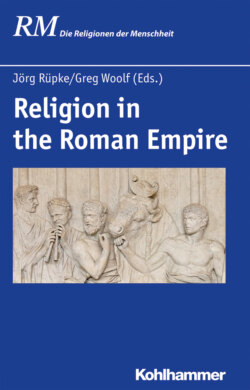Читать книгу Religion in the Roman Empire - Группа авторов - Страница 33
На сайте Литреса книга снята с продажи.
3 Costs, events and experiences: Visitors, users and religious specialists in a sanctuary
ОглавлениеSanctuaries can only be grasped if individuals and groups of people have repeatedly come there and have practiced rituals and routines that left textual or material evidence. But who are the people, who use sacred places so that they become and continue to be places of religious communication and rituals? Who comes, when and for what reason? Why are some places more frequented than others? These questions can only be answered in the respective local and historical contexts. The size, type of celebrations and number of visitors to the shrines were the factors that determined the personnel, organisational investment and the financial expenditures. Those who run sanctuaries could be cities, any Roman municipium or colonia can serve as example here,137 but also associations of people who pursued the same interests as it is the case with collegia.138 Federations of several cities also took part in or confirmed their solidarity through shared sanctuaries, such as the cities of the Syrian Decapolis139 or the Carian league at the sanctuary of Labraunda.140
In the Roman Republic as well as in the imperial period, many sanctuaries received funds for the maintenance of buildings, persons, rituals, etc. through returns from the property of the sanctuary. Additionally, the consecrations and donations of the visitors and their payment for religious services flushed money into the treasuries. The appointment of religious specialists (sacerdotes, hiereus, hiera, flamines and flaminiciae) with a financially strong background (that allowed the expenses of repeated leiturgeia and the initial summa honoraria) also makes the operation possible.141 In the case that club-like groups (collegia) were the providers of religiously used facilities or sanctuaries, i.e. associations of like-minded people and traders, the membership fees and donations by members helped run the places and activities. Several inscriptions, especially from the 2nd and 3rd centuries A.D. from Apulum, Delos, Ostia or Puteoli, attest to payments for buildings, installments to festivals, endowments with annual returns to members and the like.142 That this was not always sufficient or that the members of the collegia overstrained themselves is demonstrated by the case of the merchants from Tyros in Lebanon, who maintained a trading station in Puteoli. In the 1st century A.D. they could not guarantee the maintenance of the office in which they also worshipped their gods. The branch of Tyrian merchants at Rome had to bear the costs in the end.143
Sanctuaries such as the Asklepeion of Pergamon attracted visitors from places all over the Mediterranean. These visitors belonged in the case of Pergamon to the elites, the senatorial class, the educated upper classes and intellectuals of the Roman Empire, who were highly mobile. In addition, it was also a sacred place for the residents of the region who visited the sanctuary for thanking and asking for curments, healing and well-being. Asklepios also belongs to the gods, who met the growing interest in body practices and self-awareness in the process of »religionification« of various realms of life in the imperial period.144 This god and his sanctuaries ensured a permanent influx and presence of members of the empire-wide elites. The result of this popularity was a measure of enlargening the sacred place in the 2nd century A.D. by buildings to accommodate, entertain and cure the visitors, more porticoes and stoai, as well as an extended number of employees145 who regulated the events.146
In the East the description by Lucian of the Sanctuary of Dea Syria in Heliopolis (Manbij, Syria) and the religious practices there, does—despite arguments about the authenticity of the text—give insight into the range of people who would visit such a sanctuary.147 Lucian’s text also gives an idea about the festivals and practices as well as the ways in which such a sanctuary was full of statues, objects, people and activities at various points in time. Descriptions of such festivals are (if preserved) biased by the particular and personal view of the author(s), and Lucian is an example of this highly tendentious report on the feast of the Dea Syria in Heliopolis.
Gatherings in the provincial sanctuaries of the western provinces of the Empire might have been an impressive spectacle as well. Their architectural layout based on axiality, hierarchy, and vast open spaces as described above convey a structuring political character allowing for large assemblies, to which on the various levels of accessibility people were admitted: the population, the communal and provincial officials and the inner circle of the imperial government. Religious specialists formed a crucial part of the officials and we know from Tarraco/Tarragona, the ordered capital of the Hispania citerior, that high-ranked flamines provinciae Hispaniae were responsible for the religious acts. Their names were kept in long lists over decades.148 The temple of the large sanctuary at Tarraco itself was probably only accessible on special occasions such as anniversaries or birthdays of the emperor, and then, only for certain persons (Fig. 12).149 It is evident from the find material and the site as well as the temple complex that he played an »official« role and fulfilled less the needs of individual communication with the gods than those of the collective.150
